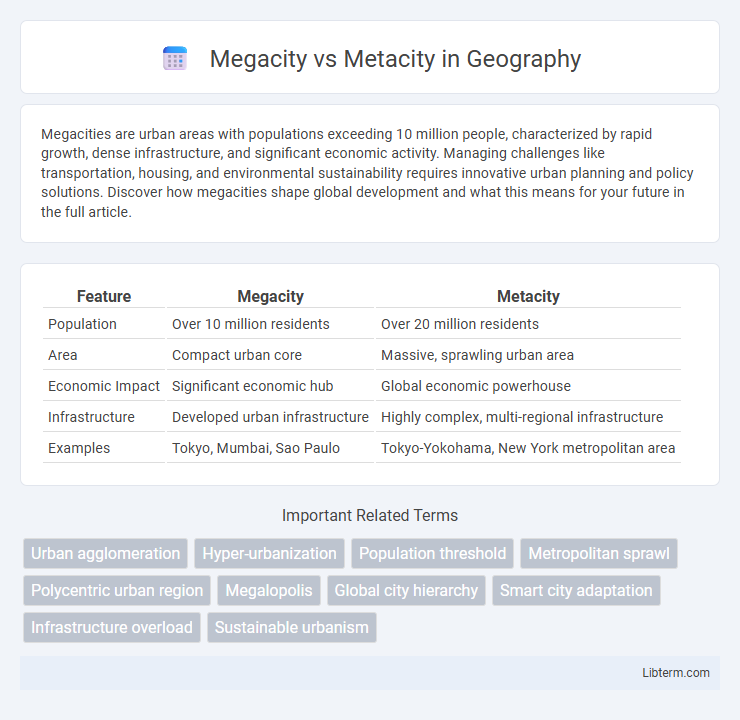Megacities are urban areas with populations exceeding 10 million people, characterized by rapid growth, dense infrastructure, and significant economic activity. Managing challenges like transportation, housing, and environmental sustainability requires innovative urban planning and policy solutions. Discover how megacities shape global development and what this means for your future in the full article.
Table of Comparison
| Feature | Megacity | Metacity |
|---|---|---|
| Population | Over 10 million residents | Over 20 million residents |
| Area | Compact urban core | Massive, sprawling urban area |
| Economic Impact | Significant economic hub | Global economic powerhouse |
| Infrastructure | Developed urban infrastructure | Highly complex, multi-regional infrastructure |
| Examples | Tokyo, Mumbai, Sao Paulo | Tokyo-Yokohama, New York metropolitan area |
Introduction to Megacities and Metacities
Megacities are urban areas with populations exceeding 10 million people, characterized by dense infrastructure and significant economic, social, and environmental challenges. Metacities, by contrast, are even larger urban regions with populations that surpass 20 million, often encompassing multiple interconnected cities and metropolitan areas. These vast urban concentrations drive major global trends in migration, urbanization, and resource demand, shaping future policies on sustainable development and urban planning.
Defining Megacities: Key Characteristics
Megacities are urban areas with populations exceeding 10 million inhabitants, characterized by intense population density, extensive infrastructure, and significant economic influence. These cities often exhibit advanced transportation networks, diverse cultural landscapes, and complex governance systems to manage growth and sustainability challenges. Key characteristics also include high levels of industrialization, substantial social stratification, and critical roles in global trade and innovation.
Unpacking Metacities: Concept and Scale
Metacities represent an advanced urban mega-structure, surpassing megacities in both population and spatial complexity, often housing over 20 million people within interconnected metropolitan regions. This concept emphasizes not just size but the integration of multiple urban centers functioning as a cohesive economic, social, and infrastructural system. Understanding metacities involves analyzing their polycentric nature, extensive transportation networks, and the challenges of governance across sprawling urban landscapes.
Population Thresholds: Megacity vs. Metacity
A megacity is defined by a population exceeding 10 million residents, while a metacity surpasses 20 million people, reflecting a larger scale of urban density and infrastructure demands. Megacities like Tokyo and New York represent significant urban hubs, whereas metacities such as the greater Tokyo metropolitan area and Delhi demonstrate unprecedented population concentrations and economic complexities. Population thresholds critically influence urban planning, resource management, and policy-making strategies to accommodate the growing demands of these expansive urban regions.
Urban Growth Drivers in Megacities and Metacities
Megacities experience urban growth driven primarily by rapid population influx, industrial expansion, and infrastructural development fueled by globalization and economic opportunities. Metacities, characterized by an extensive network of interconnected cities, grow through regional integration, technological innovation, and diversified economic activities that transcend traditional urban boundaries. Both urban forms face challenges related to sustainable development, but metacities emphasize coordinated governance to manage spatial complexity and resource distribution effectively.
Infrastructure and Urban Planning Challenges
Megacities, typically defined as urban areas with populations exceeding 10 million, face significant infrastructure challenges including overcrowded transportation systems, inadequate water supply, and strained energy grids. Metacities, with populations surpassing 20 million, encounter amplified urban planning complexities such as extensive housing deficits, sprawling informal settlements, and the need for sustainable large-scale public transit networks. Both urban forms require integrated smart technologies and resilient infrastructure solutions to manage rapid population growth and environmental impacts effectively.
Economic Impact and Opportunities
Megacities, characterized by populations exceeding 10 million, drive significant economic growth through diversified industries, large labor markets, and extensive infrastructure, creating numerous employment and innovation opportunities. Metacities, often surpassing 20 million residents, amplify these effects by fostering global trade hubs, high-value service sectors, and massive urban economies with greater scalability for technological advancements and foreign investments. Both urban forms present unique economic challenges, but metacities typically offer enhanced economic resilience and expansive markets, attracting multinational corporations and supporting sustainable urban development initiatives.
Environmental Concerns and Sustainability
Megacities, defined as urban areas with populations exceeding 10 million, face significant environmental challenges including air pollution, waste management, and high carbon emissions, which strain local ecosystems. Metacities, larger aggregations often comprising interconnected megacities with populations over 20 million, exacerbate sustainability issues due to their greater resource consumption and infrastructure demands. Implementing green technologies, sustainable urban planning, and efficient public transportation systems is essential for mitigating the environmental impact in both megacities and metacities.
Social Dynamics and Quality of Life
Megacities, characterized by populations exceeding 10 million, often face challenges such as overcrowding, pollution, and strained infrastructure that negatively impact social dynamics and quality of life. Metacities, with populations surpassing 20 million, experience intensified social stratification, housing shortages, and traffic congestion, exacerbating inequalities and stress levels among residents. Urban planning innovations and investment in public services are critical to addressing these social challenges and improving overall living conditions in both megacities and metacities.
Future Trends in Global Urbanization
Megacities, defined as urban areas with populations exceeding 10 million, continue to grow rapidly, driven by migration and economic opportunities, while metacities, networks of interconnected cities with combined populations surpassing 20 million, represent an emerging trend in regional urbanization. Future global urbanization trends indicate a shift towards polycentric development, where metacities enhance sustainable infrastructure, digital connectivity, and decentralized governance to manage their sprawling populations. Innovations in smart city technologies and integrated transportation systems will be critical in addressing challenges related to megacity congestion and metacity coordination, shaping the urban landscapes of the 21st century.
Megacity Infographic

 libterm.com
libterm.com